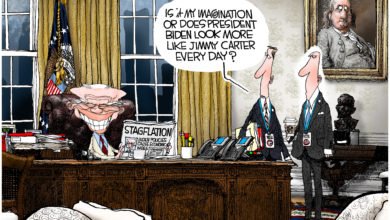Black Lives Matter Tears Down. Here’s How Black America Was Built Up

Support for the ill-defined Black Lives Matter (BLM) movement in America is in many ways a default, thanks to a lack of socially conservative alternatives. “All lives matter” and other standard retorts, such as the BLM being a Marxist front, are proving ineffective in the public discourse.
Instead, black Americans deserve a different movement, one based on the history, tradition and faith that originally created prosperity for black communities in past generations.
The BLM movement has the support of 63% of Americans, according to an ABC News/Washington Post poll. This after months of protests-turned-riots, hundreds of millions of dollars in property damage, and by early June, at least 19 people killed in connection to the demonstrations that spiraled into riots. More have been killed since.
Is support for BLM that blind? Not quite, as the same poll suggests their approval is tepid. More than half the respondents opposed defunding the police to increase social services spending, and 52% were against removing statues of historic Confederate figures. The results were also largely partisan, with 92% of Democrats backing BLM and 68% of Republicans being against the movement.
Still, the overarching brand and messaging of the BLM movement is stronger than its opposition, even if its various members do not enjoy a deep, unwavering endorsement for their multitude of demands.
The reason behind this seemingly hollow support is genuine popular demand for some cultural or political force to open up more opportunity for prosperity for black families and their communities. The BLM movement simply can’t fulfill that demand, since it is limited ideologically and tactically to tearing down systems and institutions. But BLM’s power will grow as long as it’s the only game in town.
A formidable alternative to BLM would raise up and honor the history of pre-welfare state black experiences, including the indispensable family framework as well as the community-driven mutual aid societies that provided social safety nets.
Those institutions mediated the interests between black Americans and centralized state power, just as they did for every other racial demographic in the country. The importance of institutional mediation between individuals and states cannot be overstated. Witness the weakening of families in the black community alongside the growth of the welfare state.
The predominant trend of top-down political management of society is exactly what the official Black Lives Matter organization seeks to perpetuate. Untold millions of dollars have been donated to the Black Lives Matter Global Network Foundation, which notoriously aims to “disrupt the Western-prescribed nuclear family structure,” a sentiment of 1960s radical leftism newly refurbished in “woke” form.
Thousand Currents, a grant-making nonprofit, manages the BLM foundation and has been consulting for the group since 2016. A FactCheck.org report found that nearly half of BLM’s expenditures in 2019 went to “consultant fees.” Much of the rest was spent on BLM salaries and travel.
Susan Rosenberg is Thousand Currents’s vice chair of the board of directors, as shown in this web archive. That information is only available on an archive, because her name was taken off the Thousand Currents site when it became widely known who Rosenberg is.
Rosenberg was a terrorist member of the May 19th Communist Organization, which carried out violent robberies and bombings. In 1985, she went to prison on a 58-year sentence for possession of explosives, but she was abruptly freed on President Bill Clinton’s last day in office in 2001.
Following that ideological lineage are “three radical Black organizers,” as BLM puts it on its “Herstory” page about Patrisse Cullors, Alicia Garza, and Opal Tometi. Cullors has said that she and Garza are “trained Marxists.”
These kinds of leaders may be charismatic, but if it was widely known how they’re spending the money they’re taking, their so-called supporters would probably hesitate to give more.
Contrast this revolutionary ideology with the first black mutual aid society founded in 1787. The Free African Society’s preamble described an organization “without regard to religious tenets, provided, the persons lived an orderly and sober life, in order to support one another in sickness, and for the benefit of their widows and fatherless children.”
Members of FAS would contribute “one shilling in silver Pennsylvania currency a month” to help “the needy of this Society … provided, the necessity is not brought on them by their own imprudence.”
Such a common-sense principle of charity is wholly rejected in the modern welfare state. Furthermore, the bureaucratic apparatus of the welfare state also makes it impossible for competing efforts to arise.
Compared with the results since the modern welfare state commenced with the 1960s Great Society, the black fraternal orders and mutual aid societies had a better track record and method for lifting up their communities.
The Grand Fountain of the United Order of True Reformers was founded by ex-slaves. It was the “largest and most successful black business enterprise in the United States between 1881 and 1910,” according to Encyclopedia Virginia.
The Independent Order of Saint Luke, also founded by ex-slaves, took its organization to another level by establishing its own businesses. In 1903, it founded the Saint Luke Penny Savings Bank of Richmond, where Maggie L. Walker served as the first black woman bank president.
Many black businesses rose up during that time, especially in Tulsa, Oklahoma, on Black Wall Street, and Detroit, Michigan’s Black Bottom.
The late black writer Carrie Allen McCray wrote in 1980 of “but one danger” facing black people, but it wasn’t racism. It was the threat of bureaucracy to voluntary, mutual support networks.
“For black families and black people, there is but one danger,” she wrote, “if these informal adaptive and coping mechanisms are pulled into the bureaucratic structure, the informal nature of the network and the network itself could be destroyed.”
That is precisely what accounted for the loss of so much of what black Americans built for themselves and their posterity. Needless to say, the same result afflicted every other group in the country, as documented in David Beito’s book, From Mutual Aid to the Welfare State: Fraternal Societies and Social Services, 1890-1967.
The radical demands of the BLM movement cannot be countered without an alternative vision for black America, one that is viable and answers to real needs. That means putting development above destruction. If anything is to be destroyed, let it be the intrusive bureaucracies that actually hinder growth, not statues and businesses.
Nick Hankoff is a writer, editor, and host of a new podcast launching soon at nickhankoff.com, where his other writing for the Ludwig von Mises Institute and the Advocates for Self-Government can also be found. He lives in Fort Wayne, Indiana, with his wife and their three children.
The views and opinions expressed in this commentary are those of the author and do not reflect the official position of the Daily Caller News Foundation or Conservative Daily News.
Content created by The Daily Caller News Foundation is available without charge to any eligible news publisher that can provide a large audience. For licensing opportunities of our original content, please contact licensing@dailycallernewsfoundation.org




